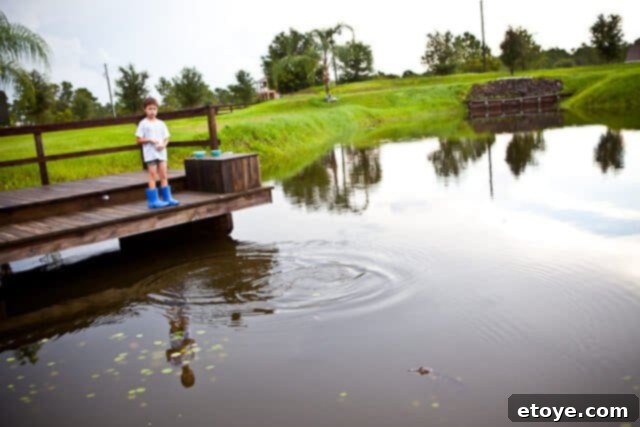Mama’s
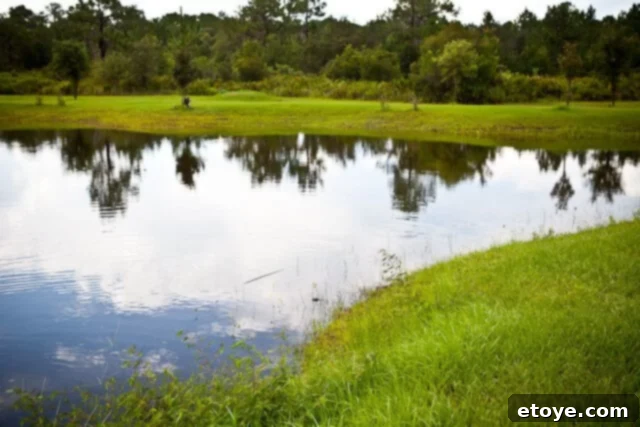
gettin’
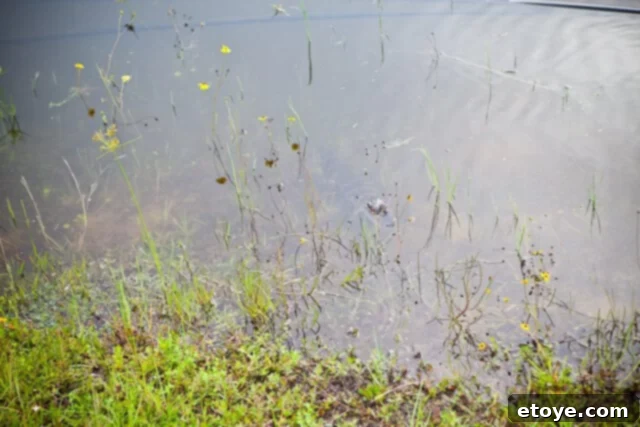
a
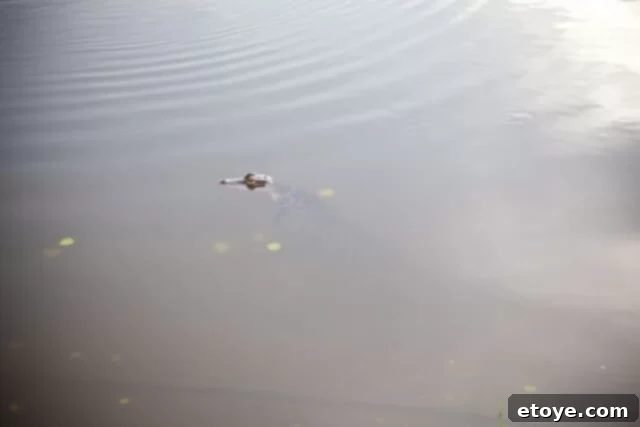
new
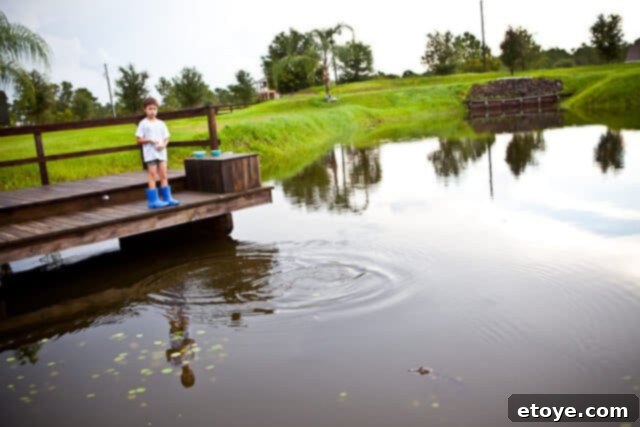
pair of shoes. or a handbag.
Lil’ baby gator, about 2 feet long. I cannot co-exist peacefully with an alligator in my pond.
Okay, so he’s not quite big enough to make a handbag. Maybe a fancy iPhone case.
The Unexpected Pond Visitor: A Tale of Alligators, Luxury, and Coexistence
The allure of luxury is undeniable. For many, a new pair of designer shoes or a meticulously crafted handbag represents more than just an accessory; it symbolizes achievement, style, and a touch of the extraordinary. Often, the most coveted items are those fashioned from exotic materials, like the supple, distinctively textured hide of an alligator. The thought of acquiring such an item can spark a delightful anticipation, a mental journey through elegant boutiques and sophisticated ensembles. Yet, sometimes, the source of such luxury makes an appearance in the most unexpected and rather inconvenient places – like a backyard pond.
Imagine the scene: a quiet morning, perhaps with a cup of coffee, surveying the tranquil waters of your own private pond. Then, a ripple, a subtle movement, and there it is – not a fish or a turtle, but a miniature prehistoric creature, an alligator. This isn’t a scene from a wildlife documentary; it’s a reality check, bringing the wild directly into your domestic space. This surprising encounter immediately shifts focus from potential luxury goods to pressing safety concerns, transforming a serene landscape into an arena of unexpected wildlife management.
The Allure of Exotic Leather: A Glimpse into High Fashion
For centuries, exotic leathers have captivated the fashion world, with alligator skin standing out as a premier choice for luxury goods. Its unique pattern, durability, and smooth, supple finish make it highly sought after by top designers and discerning consumers alike. A handbag crafted from genuine alligator skin is more than just a functional item; it’s a statement piece, a work of art that embodies elegance and exclusivity. Similarly, shoes and other accessories made from this prestigious material command attention and respect, symbolizing a blend of traditional craftsmanship and contemporary style.
The journey from a wild animal to a coveted fashion item is complex and, at times, controversial. Responsible sourcing and ethical practices are paramount in the exotic leather industry, with strict regulations governing trade to ensure sustainability and animal welfare. However, the sheer tactile beauty and visual appeal of alligator leather continue to drive its demand in the high-fashion market. The exquisite texture and the promise of enduring quality make these items a worthwhile investment for those who appreciate the finer things in life, reflecting a legacy of luxury that transcends fleeting trends.

A Two-Foot Surprise: Encountering Wildlife in Your Backyard
The discovery of a “Lil’ baby gator, about 2 feet long” in a residential pond is far from an everyday occurrence for most homeowners, yet it’s a growing reality in regions where human habitats increasingly encroach upon natural wetlands. While a two-foot alligator might seem small, its presence immediately raises significant concerns. The initial shock of finding such a creature quickly gives way to a practical dilemma: “I cannot co-exist peacefully with an alligator in my pond.” This sentiment perfectly encapsulates the tension between appreciating wildlife from a distance and dealing with its immediate, tangible presence in one’s personal space.
Even a juvenile alligator possesses the instincts and potential for growth that make it a formidable neighbor. These creatures are opportunistic predators, and while a two-foot gator might not pose an immediate threat to an adult human, it can certainly be dangerous to pets or small children. Furthermore, a small alligator is rarely content to stay small; it will grow, and its territorial instincts will strengthen. Ponds and water features in residential areas often attract alligators looking for food, shelter, or simply a new territory, especially during warmer months or mating seasons. Understanding the implications of such an encounter is the first step toward responsible action.

Nuisance Alligators: When Coexistence Isn’t an Option
The concept of a “nuisance alligator” is critical in wildlife management. Generally, an alligator is considered a nuisance when it poses a threat to people, pets, or property. Even a relatively small alligator, like the two-footer described, can escalate into a nuisance if it loses its natural fear of humans, is fed by people, or becomes territorial in a populated area. The presence of an alligator in a backyard pond, especially one used by residents or pets, unequivocally falls into the nuisance category because it creates an inherent risk.
The dangers are multifaceted. Alligators can move surprisingly quickly on land and in water. They possess immense bite force and sharp teeth, capable of causing serious injury. Beyond direct attacks, their presence can create significant psychological distress for residents, fostering a constant sense of unease and restricting the use of their own property. Children can be particularly vulnerable due to their small size and natural curiosity. Therefore, simply letting the alligator “be” is rarely a viable or safe long-term solution. Proactive and responsible measures are necessary to ensure the safety of both the human inhabitants and the alligator itself.
Responsible Wildlife Management: What to Do
When faced with an alligator in a residential pond, the immediate priority is safety and responsible management. The first and most crucial step is never to approach or feed the alligator. Feeding alligators habituates them to humans, making them lose their natural caution and increasing the likelihood of aggressive encounters. Instead, immediately contact your local wildlife authorities or a state-approved nuisance alligator removal program. Agencies like the Florida Fish and Wildlife Conservation Commission (FWC) have dedicated programs for safely and humanely removing alligators that pose a threat.
These professionals are trained to capture alligators without harming the animal or endangering the public. They understand alligator behavior, possess the necessary equipment, and adhere to strict protocols for relocation or, if absolutely necessary, euthanasia. Attempting to capture or relocate an alligator yourself is extremely dangerous and ill-advised. Furthermore, taking steps to make your property less attractive to alligators – such as keeping pets away from the water’s edge, properly disposing of fish scraps, and ensuring garbage cans are securely closed – can help prevent future encounters. Responsible action ensures that both human safety and wildlife welfare are prioritized.
From Pond Predator to Potential Product? The Dark Humor of the Situation
The original musing, “Okay, so he’s not quite big enough to make a handbag. Maybe a fancy iPhone case,” injects a layer of dark humor into the otherwise serious situation. This playful, almost macabre thought highlights the stark contrast between the immediate concern of a wild animal’s presence and the abstract concept of it as a resource for luxury goods. It’s a testament to the human capacity to find levity in uncomfortable truths, juxtaposing the fear or inconvenience of a creature in one’s pond with its perceived value as a raw material.
This thought process, however fleeting, also subtly underscores the complex relationship between humans and nature. We admire the beauty of wild animals, yet often view them through a lens of utility or aesthetic appeal. While the practical reality dictates humane removal for safety, the whimsical consideration of an iPhone case made from the very gator causing the stir reveals a deeper cultural connection to exotic materials. It reminds us that while we desire the luxurious outputs, the raw, untamed source of those materials often presents a very different, more challenging reality when it appears on our doorstep.

Beyond the Pond: Understanding Alligator Conservation
While dealing with a nuisance alligator in a residential pond is a localized problem requiring immediate attention, it’s also important to consider the broader context of alligator conservation. American alligators were once an endangered species, pushed to the brink of extinction by habitat loss and unregulated hunting. However, through robust conservation efforts and protective legislation, they have made a remarkable recovery, so much so that they are now a conservation success story. This recovery has led to their populations thriving, which in turn leads to more frequent interactions with human populations in developing areas.
Alligators play a crucial ecological role as apex predators in their wetland ecosystems. They help maintain the balance of their environment by controlling populations of other species and creating “gator holes” which provide vital water sources for other wildlife during dry periods. Understanding their ecological significance helps us appreciate these ancient reptiles beyond just the immediate threat they might pose in a backyard setting. Responsible management of nuisance alligators is not just about human safety; it’s also about maintaining healthy alligator populations in their natural habitats while minimizing conflict with people.
Conclusion: Navigating Nature’s Surprises with Responsibility
The encounter with a two-foot alligator in a residential pond serves as a potent reminder of the thin veil between human civilization and the wild world. It highlights the contrasting desires for luxury goods derived from nature and the practical, sometimes challenging, realities of coexisting with that very nature. While the thought of a new alligator-skin handbag or phone case might evoke images of high fashion and sophisticated taste, the actual presence of a wild alligator in one’s pond necessitates a shift from aesthetic appreciation to pragmatic wildlife management.
Ultimately, navigating such surprises requires a blend of respect for wildlife, a commitment to safety, and a clear understanding of responsible action. Instead of attempting personal interventions or succumbing to the humorous but impractical idea of harvesting the creature for a luxury item, the appropriate response is always to contact wildlife professionals. This approach ensures the safety of all involved – humans, pets, and the alligator itself – reinforcing the principle that while nature can be unpredictable, our response to it can and should always be responsible and informed.
